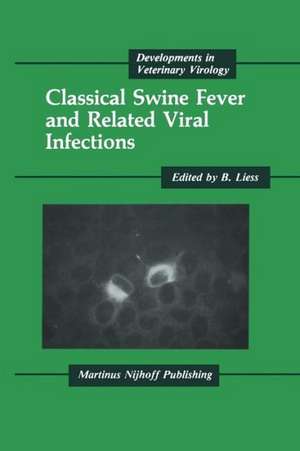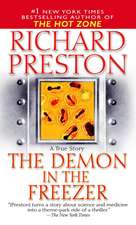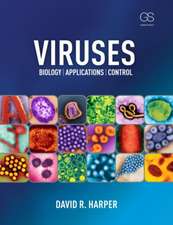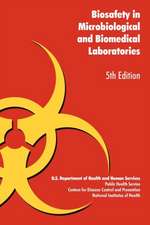Classical Swine Fever and Related Viral Infections: Developments in Veterinary Virology, cartea 5
Editat de B. Liessen Limba Engleză Paperback – 21 sep 2011
| Toate formatele și edițiile | Preț | Express |
|---|---|---|
| Paperback (1) | 945.47 lei 6-8 săpt. | |
| Springer Us – 21 sep 2011 | 945.47 lei 6-8 săpt. | |
| Hardback (1) | 951.47 lei 6-8 săpt. | |
| Springer Us – 31 oct 1987 | 951.47 lei 6-8 săpt. |
Preț: 945.47 lei
Preț vechi: 1153.02 lei
-18% Nou
Puncte Express: 1418
Preț estimativ în valută:
180.92€ • 189.28$ • 150.29£
180.92€ • 189.28$ • 150.29£
Carte tipărită la comandă
Livrare economică 02-16 aprilie
Preluare comenzi: 021 569.72.76
Specificații
ISBN-13: 9781461292357
ISBN-10: 1461292352
Pagini: 316
Ilustrații: XIV, 298 p.
Dimensiuni: 155 x 235 x 17 mm
Greutate: 0.45 kg
Ediția:1988
Editura: Springer Us
Colecția Springer
Seria Developments in Veterinary Virology
Locul publicării:New York, NY, United States
ISBN-10: 1461292352
Pagini: 316
Ilustrații: XIV, 298 p.
Dimensiuni: 155 x 235 x 17 mm
Greutate: 0.45 kg
Ediția:1988
Editura: Springer Us
Colecția Springer
Seria Developments in Veterinary Virology
Locul publicării:New York, NY, United States
Public țintă
ResearchCuprins
1. Description of the virus infection.- 1. Introduction.- 2. Viral and host determinants of virulence.- 3. Infections with high-virulent virus strains.- 4. Infections with moderate-virulent virus strains.- 5. Infections with low-virulent virus strains.- 6. Infections with avirulent virus strains.- 7. Concluding remarks.- 2. Pathology and pathogenesis of the disease.- 1. Introduction.- 2. Pathology of classical swine fever.- 3. Light and electron microscopical changes.- 4. Haematological findings.- 5. Blood coagulation disorders.- 6. Foetal and neonatal pathology.- 7. Congenital persistent HC virus infection.- 8. Pathogenesis of HC virus infection.- 9. Concluding remarks.- 3. Characteristics of the virus.- 1. Virion morphology.- 2. Physico-chemical properties.- 3. Isolation and cultivation.- 4. Viral strains.- 5. Serological relationship to other pestiviruses.- 4. Molecular biology of the virus.- 1. Introduction.- 2. Taxonomy.- 3. Molecular biology of the togaviruses.- 4. Ribonucleic acid of pestiviruses.- 5. Structural proteins of pestiviruses.- 6. Replication, strain differences and mutants of pestiviruses.- 7. Conclusions.- 5. Diagnostic procedures.- 1. Introduction.- 2. Laboratory diagnosis.- 3. Characteristics of isolates from field outbreaks.- 4. Concluding remarks.- 6. Serology.- 1. Introduction.- 2. Serologic reactions used for humoral antibody detection.- 3. Application of serological methods.- 4. Concluding remarks.- 7. Immunological aspects of the infection.- 1. Introduction.- 2. Humoral immune response.- 3. Cellular immune response.- 4. Effects of HCV infections on immune functions.- 5. Discussion and concluding remarks.- 8. Principles of vaccination.- 1. Introduction.- 2. Types of vaccines.- 3. Properties of modern live virus vaccines.- 4. Immunity induced by modern live virus vaccines.- 5. Use of modern live virus vaccines.- 6. Vaccination failures.- 7. Appraisal of vaccination: Epizootiological and economic impact.- 9. Vaccines.- 1. Introduction.- 2. Production of HCV vaccines.- 3. Properties of HCV vaccines.- 4. Conclusions.- 10. Epizootiology of hog cholera.- 1. Introduction.- 2. Distribution and economic impact.- 3. Transmission.- 4. Reservoirs.- 5. Factors influencing the epizootiology.- 6. Tracing of herds infected with HC.- 7. Concluding remarks.- 11. Control of classical swine fever.- 1. Introduction.- 2. The epidemiologic situation.- 3. The structure of the pig production.- 4. Public control of CSF.- 5. The legislation of the EEC on CSF.- 6. Legal measures against CSF in case of emergency situations.- 7. The EEC programme for eradication of CSF.- 8. The CSF epizootic in Belgium, the Netherlands and the Federal Republic of Germany.- 9. Concluding remarks.- 12. The comparative biology of classicle swine fever.- 1. Introduction.- 2. Prenatal infection.- 3. The legacy of intra-uterine infection.- 4. Acute postnatal infections.- 5. Epidemiology and control.
Recenzii
"All those concerned with the diagnosis, research or control of classical swine fever/hog cholera should study this book, and will undoubtedly come to regard it as an essential work of reference." (S. Edwards in Tropical Animal Health and Production, 21,1989)
















